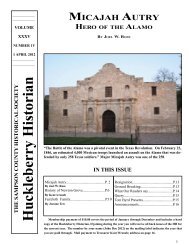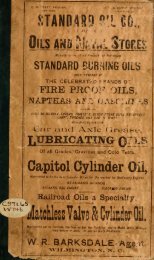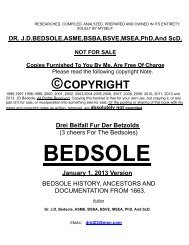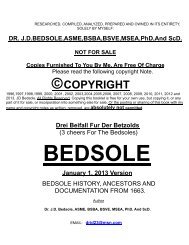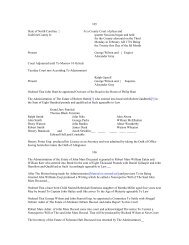11/25/07 VERSION: BEDSOLE HISTORY FROM 1673 ... - NCGenWeb
11/25/07 VERSION: BEDSOLE HISTORY FROM 1673 ... - NCGenWeb
11/25/07 VERSION: BEDSOLE HISTORY FROM 1673 ... - NCGenWeb
You also want an ePaper? Increase the reach of your titles
YUMPU automatically turns print PDFs into web optimized ePapers that Google loves.
could ever do. As it was done back in the 1700’s, it was still being done like this in<br />
my lifetime: The pine trees were scarred by cutting the bark 6 to 8 times in the shape<br />
of letter V’s, so that all the points of convergence of the cuts, caused the resulting<br />
“Bleeding” turpentine to flow down the cuts and drip ever so slowly into small oblong,<br />
metal cups, mounted and fastened to the trees with nails.<br />
Every 15 days or so, each cup had to be cleaned and scraped out and all the<br />
turpentine collected from them emptied into small, five gallon buckets, which were<br />
then carried by two people, to the waiting mule or ox-drawn carts or wagons where it<br />
was poured and scraped into 40 to 50 gallon barrels. This was then carried to a “mill”<br />
where the turpentine was cooked until the majority of water in it had evaporated and<br />
what was left was a black, thick and sticky goo, which is true tar.<br />
This was sold and traded for other, more needed goods. It was also shipped to<br />
England where it was used to soak tough hemp cords which were then used to pack<br />
into and seal cracks between the planks of the hulls of ships. Much tar was needed<br />
by England and as time went on, with more and more such ships being produced in<br />
this country, more and more tar was bought, sold and traded here too. The big<br />
problem was, the worker invariably got the sticky turpentine all over himself, his hair,<br />
clothes, hands, tools, barrels, boxes and everything else he touched or came into<br />
contact with.<br />
Back Then<br />
Religion<br />
When without a church, and at the earliest opportunity, the people would gather and<br />
begin building a “Brush Arbor”, which consisted of several sapling trees, cut down<br />
and trimmed and set into the ground as uprights. This was then crisscrossed on top<br />
with more small limbs and covered<br />
with small, leafy limbs and grass, to provide a kind of shelter to ward off the hot sun<br />
and the nightly dews. Crude benches were also crafted from half-logs with wooden<br />
pegs as legs, which served as seats. The Brush Arbor was usually built in the edge<br />
of someone’s pasture and was used as a temporary church. People then were very<br />
religious and faithfully attended their churches and practiced what they preached in<br />
terms of their personal conduct, speech, and daily practices.<br />
Almost all the early Bedsoles belonged to a church, usually of the Quaker faith.<br />
Those churches were very strict about their members and anyone living in the area<br />
who did not join, or who were "kicked out " would be shunned and ostracized by<br />
church members. Little or no credit was extended to them. Trade with such<br />
neighbors was almost non-existent. The non-members could not count on help when<br />
it was needed from their neighbors. So, it greatly benefitted all to join the local<br />
church. Not to do so, was certain to end in numerous additional hardships for the<br />
family of the refuser.<br />
Any time a church found out one of its members was drinking alcohol, mistreating



